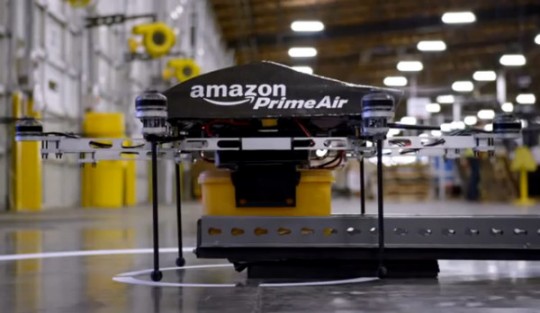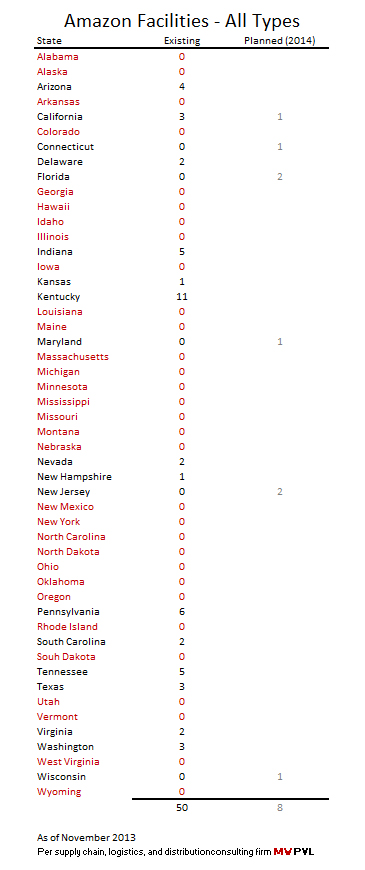What a fine bit of marketing genius by a company I respect and patronize!
Amazon stole headlines all last weekend, on the eve of Cyber Monday 2013 (biggest online shopping day ever), with a primetime television feature on 60 Minutes and the release of the Amazon Prime Air video.
Amazon Prime Air Video
So what do we have here? We have the suggestion that delivery drone copters will bring Amazon packages to you within 30 minutes.
This suggestion drew predictably mixed reactions – from “Absolute nonsense! It simply can’t be done.” to “OMFG, this is the new sliced bread! Now pick me up off the floor so I can pass out again from the proper blend of befuddlement and elation that every member of the flock of consuming sheeple should be experiencing right now.”
Naturally, the extremes have little relationship with reality, so let’s take a few minutes to get real about the Amazon Prime Air video.
Robots, People … Robots!
First, I found it quaint and a little humorous that a video about drone delivery service pretends that a human would select, box, and add to the line your product selection. Certainly, humans will continue to be involved, but the goal of efficient order fulfillment is obvious: complete automation. This is related. And so is this.
What’s Real
- Small, inexpensive drone copters – Here’s a quadcopter I’ve flown that’s somewhat similar to Amazon’s more expensive, complex, and durable octocopter.
- Tremendous resources and expertise – Amazon’s got about $8 billion in cash, a very clear motive to make this work, and a competency around online fulfillment, logistics, and distribution rivaled only by Walmart.
- Consumer appetite – The culture of impatience and desire for instant gratification continue to grow; I expect strong demand for ever-faster delivery.
What’s Questionable
- Weather – Wind and precipitation are easy and obvious go-to’s for challenges facing consistent, half hour fulfillment by drone flight.
- Obstacles – Trees, birds, power lines, cell towers, new buildings, and countless other obstacles are certain to greet your Amazon Prime Air delivery drone on the regular; the skies are not mapped as are streets (more on this in Hurdles, below).
- Returns – If returns are by drone, people will be given the responsibility of properly loading the drone (safety threat). If they’re done traditionally by FedEx, UPS, USPS or similar, people will need their own packaging (annoyance). If return processing is centralized (highly likely), Amazon would be moving from a non-stop return (straight from your home to the return facility) to a multi-stop return process (drone to nearest facility, then to return facility). Meanwhile, return or no return, how is Amazon getting all those plastic tubs back?
- Theft or Damage – Theft of the delivered product seems more likely with drones than with today’s delivery drivers. Despite GPS trackers and on-board cameras, the drones themselves would also be targets for vandals and miscreants of all sorts (if only for the sport of it).
- Hacking – As quickly as stories went up about Amazon Prime Air, so, too, did stories about hacking the delivery drones. They can be taken off route for any of a variety of reasons, every one of which would delay or deny your delivery
Fundamental Hurdles
- Safety – I’m not sure about you, but I despise the idea of thousands of drones cruising through cities and over countrysides. Certain, periodic failures immediately conjure images of space junk and the Great Pacific Garbage Patch. Whether by hardware malfunction, software malfunction, or simple wind gust, the 100 pound octocopters are certain to injure people and property.
- Mapping and Politics – Here’s where the Federal Aviation Administration comes in … maps in the sky. They exist for large aircraft, but not for small drones. While driverless cars operate based on a blend of road mapping, GPS, and on-board sensors, the increased safety risks, less-established traffic routes, and numerous obstacles of thousands of concurrent, low altitude flights will require a fat lot of negotiation, all of which will be politically charged.
- Proliferation – Where do we draw the line on flying drones? How many are too many? Just as Volvo is testing their own driverless cars, UPS is already said to be in the delivery by drone race.
- Destinations -An apartment building with thousands of residents. An office complex. Where, exactly, does the drone deliver?
- Fulfillment Model – This one’s the most interesting to me. Amazon’s model seems to be based on a network of large (many at 1 million square feet!), dispersed facilities. By the end of 2014, their distribution network should consist of 58 facilities in just 19 of the 50 United States (see below). Not all of these are fulfillment centers; some specialize in returns and one is dedicated exclusively to Zappos. In contrast and at odds with this structure, the promise of 30 minute delivery to any significant share of the US consumer population would require dozens, scores, or even hundreds more facilities, each of which would likely be much smaller and therefore be of smaller inventory. This is a significant shift in operations and in the supporting economics.
The Bottom Line
There’s no question that Amazon, other companies, and even our federal government can overcome most of the “questionables” and hurdles listed above, as well as all those not mentioned here.
Pioneering spirit and consumer demand will help drive a renewed push to same day delivery (a Holy Grail trail of fail). We’ll eventually arrive at solutions to current challenges that will make it more financially and logistically feasible than it is today.
Still … is nothing sacred? How badly do we need stuff delivered to us? And how quickly? So badly that we’d litter our skies with armies of delivery drones to drop packages of things that weigh less than 5 pounds at our doorsteps all day and night? Really!?
Because we can doesn’t mean we should – not that we’ve refused to cross that line before, especially in the face of commercial pressures.
Let’s hope that the Amazon Prime Air video is what it seems to be … a good bit of marketing genius on the eve of the biggest online shopping day in history.
Exceptions to “Really!?”
I can think of several valuable and justified uses of drones for deliveries. Most involve either to emergency situations and first responders or to battlefields and troops. None involve Kindles, Nerf guns, or socks.


Bravo. I was thinking through all of these issues too and came to the conclusion in my mind that this whole thing was just one amazing marketing strategy to help drive innovation within their own ranks. Good stuff.
Thanks so much, Matt. In the process of organizing (loosely) these thoughts, I arrived at the conclusion that it’s definitely possible, but that it’s not desirable.